Strategic Procurement Analysis for the Kingston University Project
VerifiedAdded on 2022/05/11
|17
|5073
|34
Report
AI Summary
This report provides a comprehensive analysis of a procurement strategy designed for the Kingston University project. It begins with an introduction outlining the importance of a strategic approach, defining objectives, and performance measurements. The report then delves into a strategic approach to procurement, including analyzing expenditure, identifying needs, studying the market, setting realistic objectives, and implementing procurement guidelines. It explores various alternative procurement routes, such as traditional procurement, design and build, and construction management. Advanced procurement practices, including cloud-based tools, spend transparency, supplier engagement, optimized inventory, and contract management, are also discussed. The report examines factors influencing procurement strategy, including external factors, client characteristics, and cost considerations. It concludes with potential benefits of adopting alternative procurement strategies, future strategy development, and a budget breakdown for the project.
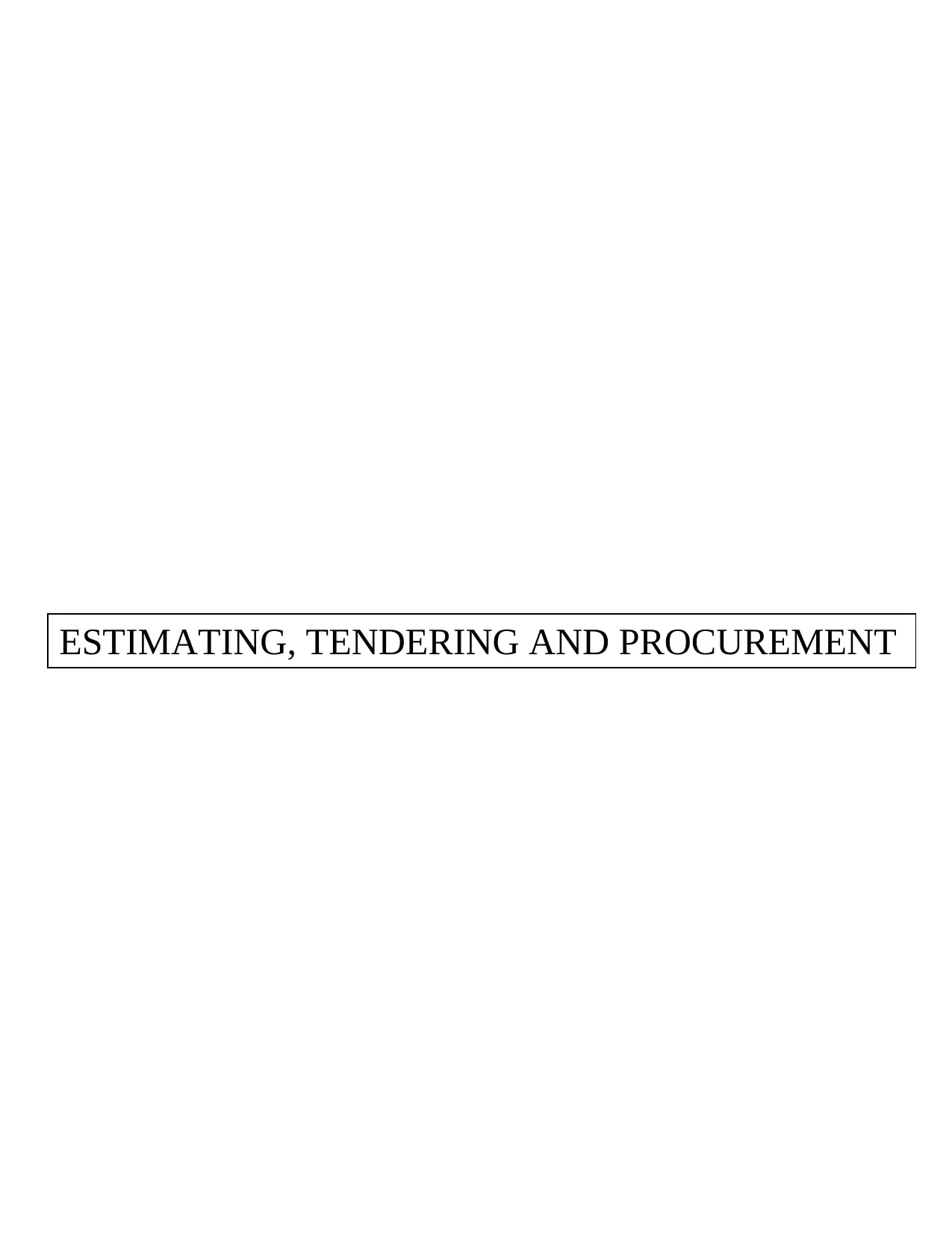
ESTIMATING, TENDERING AND PROCUREMENT
Paraphrase This Document
Need a fresh take? Get an instant paraphrase of this document with our AI Paraphraser
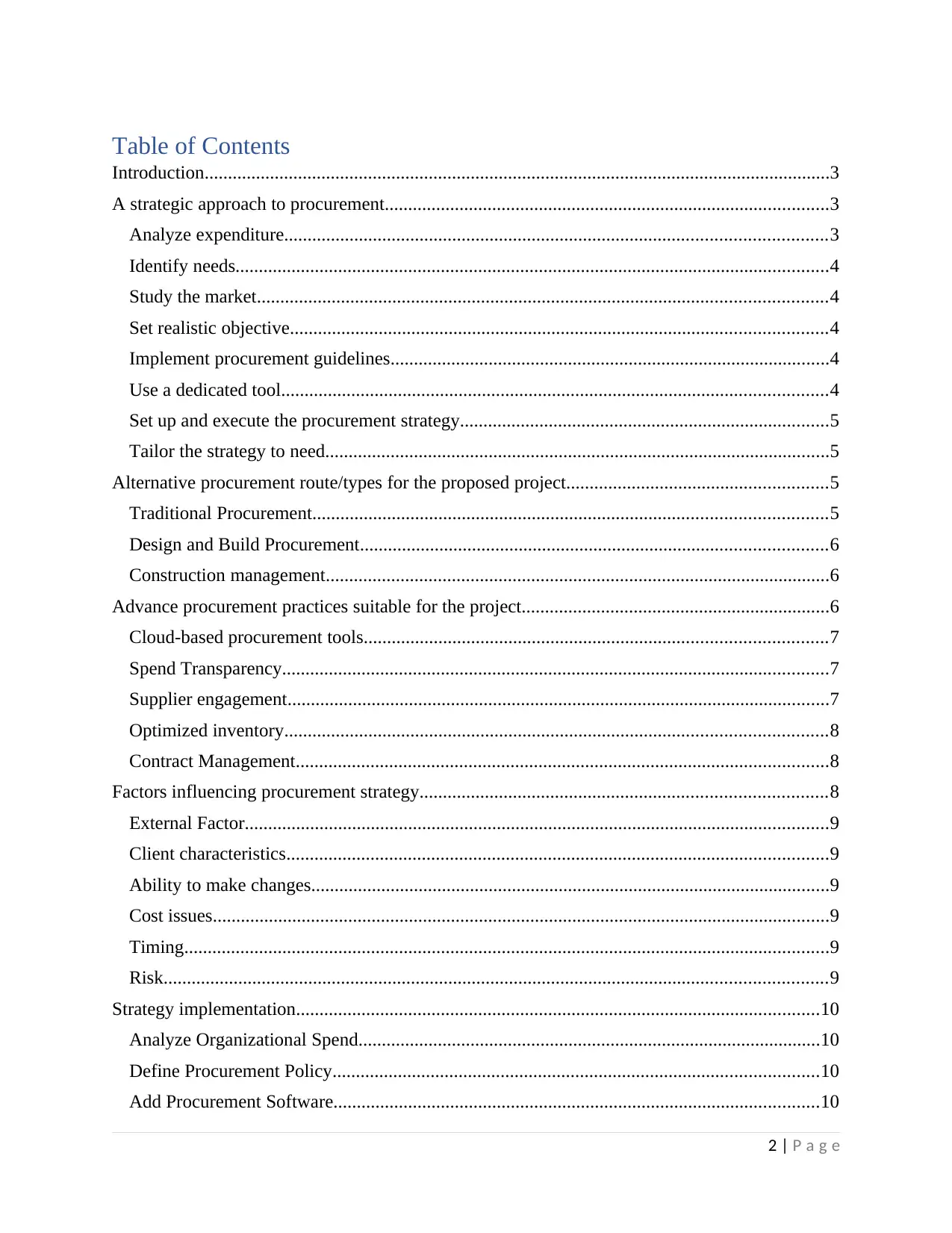
Table of Contents
Introduction......................................................................................................................................3
A strategic approach to procurement...............................................................................................3
Analyze expenditure....................................................................................................................3
Identify needs...............................................................................................................................4
Study the market..........................................................................................................................4
Set realistic objective...................................................................................................................4
Implement procurement guidelines..............................................................................................4
Use a dedicated tool.....................................................................................................................4
Set up and execute the procurement strategy...............................................................................5
Tailor the strategy to need............................................................................................................5
Alternative procurement route/types for the proposed project........................................................5
Traditional Procurement..............................................................................................................5
Design and Build Procurement....................................................................................................6
Construction management............................................................................................................6
Advance procurement practices suitable for the project..................................................................6
Cloud-based procurement tools...................................................................................................7
Spend Transparency.....................................................................................................................7
Supplier engagement....................................................................................................................7
Optimized inventory....................................................................................................................8
Contract Management..................................................................................................................8
Factors influencing procurement strategy.......................................................................................8
External Factor.............................................................................................................................9
Client characteristics....................................................................................................................9
Ability to make changes...............................................................................................................9
Cost issues....................................................................................................................................9
Timing..........................................................................................................................................9
Risk..............................................................................................................................................9
Strategy implementation................................................................................................................10
Analyze Organizational Spend...................................................................................................10
Define Procurement Policy........................................................................................................10
Add Procurement Software........................................................................................................10
2 | P a g e
Introduction......................................................................................................................................3
A strategic approach to procurement...............................................................................................3
Analyze expenditure....................................................................................................................3
Identify needs...............................................................................................................................4
Study the market..........................................................................................................................4
Set realistic objective...................................................................................................................4
Implement procurement guidelines..............................................................................................4
Use a dedicated tool.....................................................................................................................4
Set up and execute the procurement strategy...............................................................................5
Tailor the strategy to need............................................................................................................5
Alternative procurement route/types for the proposed project........................................................5
Traditional Procurement..............................................................................................................5
Design and Build Procurement....................................................................................................6
Construction management............................................................................................................6
Advance procurement practices suitable for the project..................................................................6
Cloud-based procurement tools...................................................................................................7
Spend Transparency.....................................................................................................................7
Supplier engagement....................................................................................................................7
Optimized inventory....................................................................................................................8
Contract Management..................................................................................................................8
Factors influencing procurement strategy.......................................................................................8
External Factor.............................................................................................................................9
Client characteristics....................................................................................................................9
Ability to make changes...............................................................................................................9
Cost issues....................................................................................................................................9
Timing..........................................................................................................................................9
Risk..............................................................................................................................................9
Strategy implementation................................................................................................................10
Analyze Organizational Spend...................................................................................................10
Define Procurement Policy........................................................................................................10
Add Procurement Software........................................................................................................10
2 | P a g e
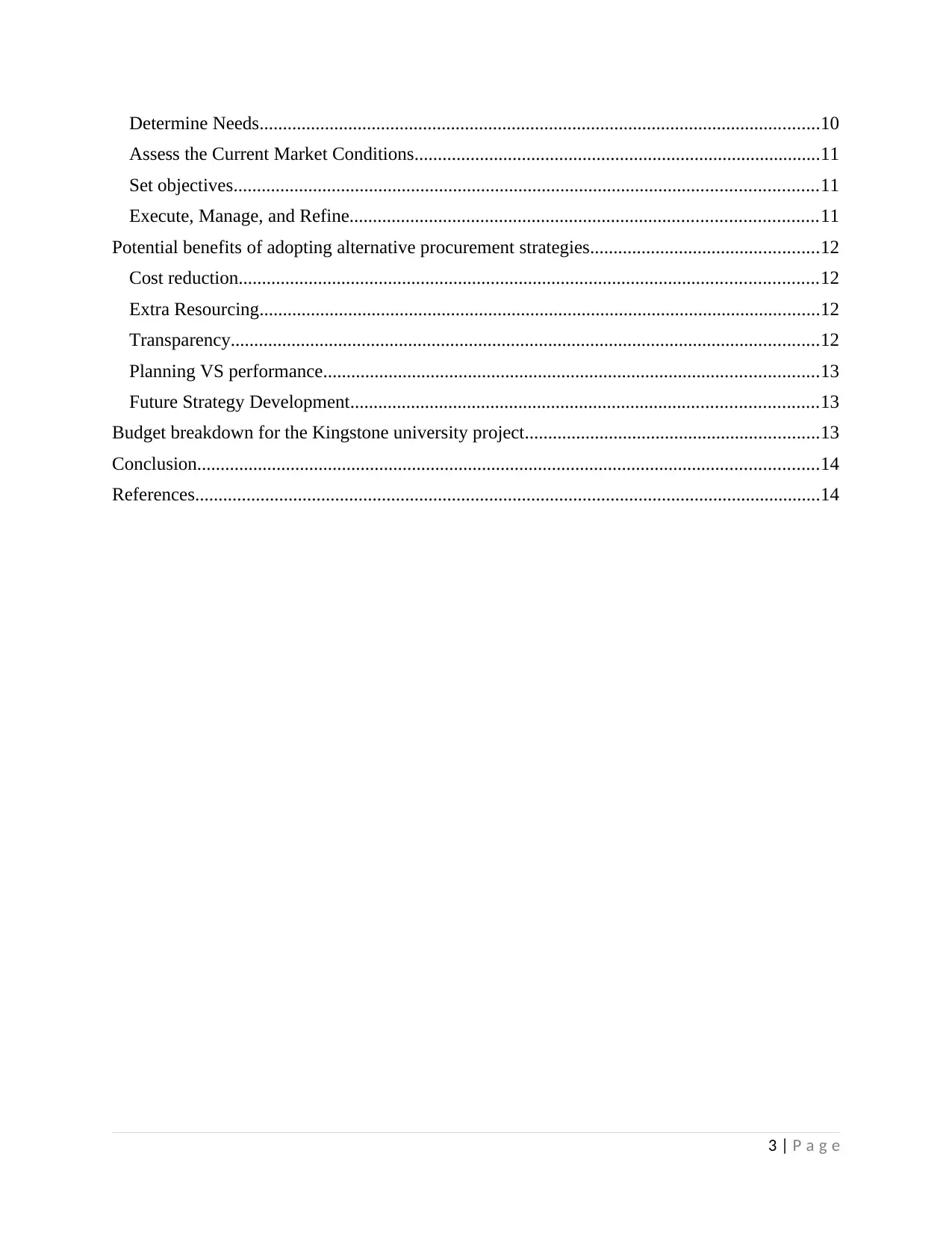
Determine Needs........................................................................................................................10
Assess the Current Market Conditions.......................................................................................11
Set objectives.............................................................................................................................11
Execute, Manage, and Refine....................................................................................................11
Potential benefits of adopting alternative procurement strategies.................................................12
Cost reduction............................................................................................................................12
Extra Resourcing........................................................................................................................12
Transparency..............................................................................................................................12
Planning VS performance..........................................................................................................13
Future Strategy Development....................................................................................................13
Budget breakdown for the Kingstone university project...............................................................13
Conclusion.....................................................................................................................................14
References......................................................................................................................................14
3 | P a g e
Assess the Current Market Conditions.......................................................................................11
Set objectives.............................................................................................................................11
Execute, Manage, and Refine....................................................................................................11
Potential benefits of adopting alternative procurement strategies.................................................12
Cost reduction............................................................................................................................12
Extra Resourcing........................................................................................................................12
Transparency..............................................................................................................................12
Planning VS performance..........................................................................................................13
Future Strategy Development....................................................................................................13
Budget breakdown for the Kingstone university project...............................................................13
Conclusion.....................................................................................................................................14
References......................................................................................................................................14
3 | P a g e
⊘ This is a preview!⊘
Do you want full access?
Subscribe today to unlock all pages.

Trusted by 1+ million students worldwide
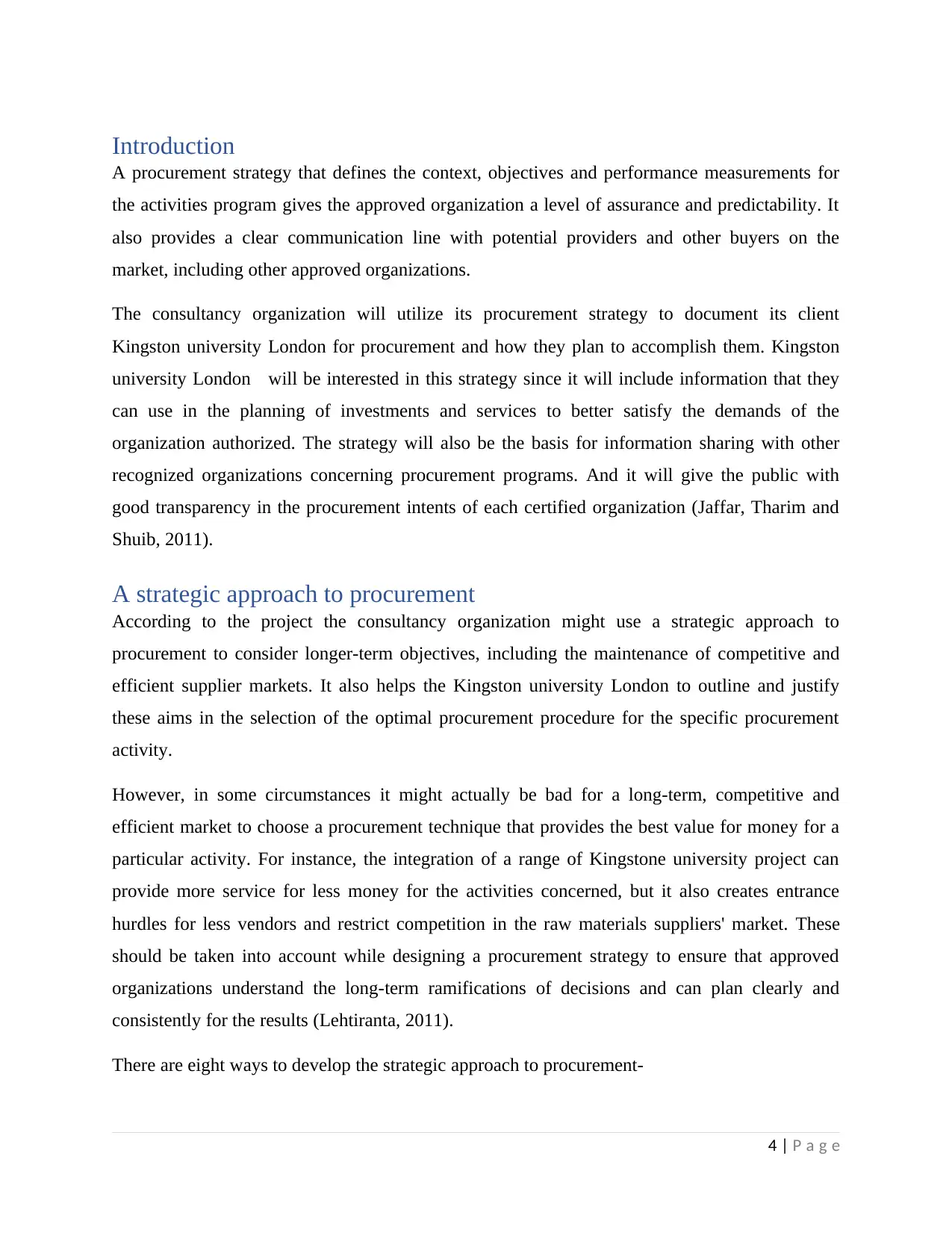
Introduction
A procurement strategy that defines the context, objectives and performance measurements for
the activities program gives the approved organization a level of assurance and predictability. It
also provides a clear communication line with potential providers and other buyers on the
market, including other approved organizations.
The consultancy organization will utilize its procurement strategy to document its client
Kingston university London for procurement and how they plan to accomplish them. Kingston
university London will be interested in this strategy since it will include information that they
can use in the planning of investments and services to better satisfy the demands of the
organization authorized. The strategy will also be the basis for information sharing with other
recognized organizations concerning procurement programs. And it will give the public with
good transparency in the procurement intents of each certified organization (Jaffar, Tharim and
Shuib, 2011).
A strategic approach to procurement
According to the project the consultancy organization might use a strategic approach to
procurement to consider longer-term objectives, including the maintenance of competitive and
efficient supplier markets. It also helps the Kingston university London to outline and justify
these aims in the selection of the optimal procurement procedure for the specific procurement
activity.
However, in some circumstances it might actually be bad for a long-term, competitive and
efficient market to choose a procurement technique that provides the best value for money for a
particular activity. For instance, the integration of a range of Kingstone university project can
provide more service for less money for the activities concerned, but it also creates entrance
hurdles for less vendors and restrict competition in the raw materials suppliers' market. These
should be taken into account while designing a procurement strategy to ensure that approved
organizations understand the long-term ramifications of decisions and can plan clearly and
consistently for the results (Lehtiranta, 2011).
There are eight ways to develop the strategic approach to procurement-
4 | P a g e
A procurement strategy that defines the context, objectives and performance measurements for
the activities program gives the approved organization a level of assurance and predictability. It
also provides a clear communication line with potential providers and other buyers on the
market, including other approved organizations.
The consultancy organization will utilize its procurement strategy to document its client
Kingston university London for procurement and how they plan to accomplish them. Kingston
university London will be interested in this strategy since it will include information that they
can use in the planning of investments and services to better satisfy the demands of the
organization authorized. The strategy will also be the basis for information sharing with other
recognized organizations concerning procurement programs. And it will give the public with
good transparency in the procurement intents of each certified organization (Jaffar, Tharim and
Shuib, 2011).
A strategic approach to procurement
According to the project the consultancy organization might use a strategic approach to
procurement to consider longer-term objectives, including the maintenance of competitive and
efficient supplier markets. It also helps the Kingston university London to outline and justify
these aims in the selection of the optimal procurement procedure for the specific procurement
activity.
However, in some circumstances it might actually be bad for a long-term, competitive and
efficient market to choose a procurement technique that provides the best value for money for a
particular activity. For instance, the integration of a range of Kingstone university project can
provide more service for less money for the activities concerned, but it also creates entrance
hurdles for less vendors and restrict competition in the raw materials suppliers' market. These
should be taken into account while designing a procurement strategy to ensure that approved
organizations understand the long-term ramifications of decisions and can plan clearly and
consistently for the results (Lehtiranta, 2011).
There are eight ways to develop the strategic approach to procurement-
4 | P a g e
Paraphrase This Document
Need a fresh take? Get an instant paraphrase of this document with our AI Paraphraser
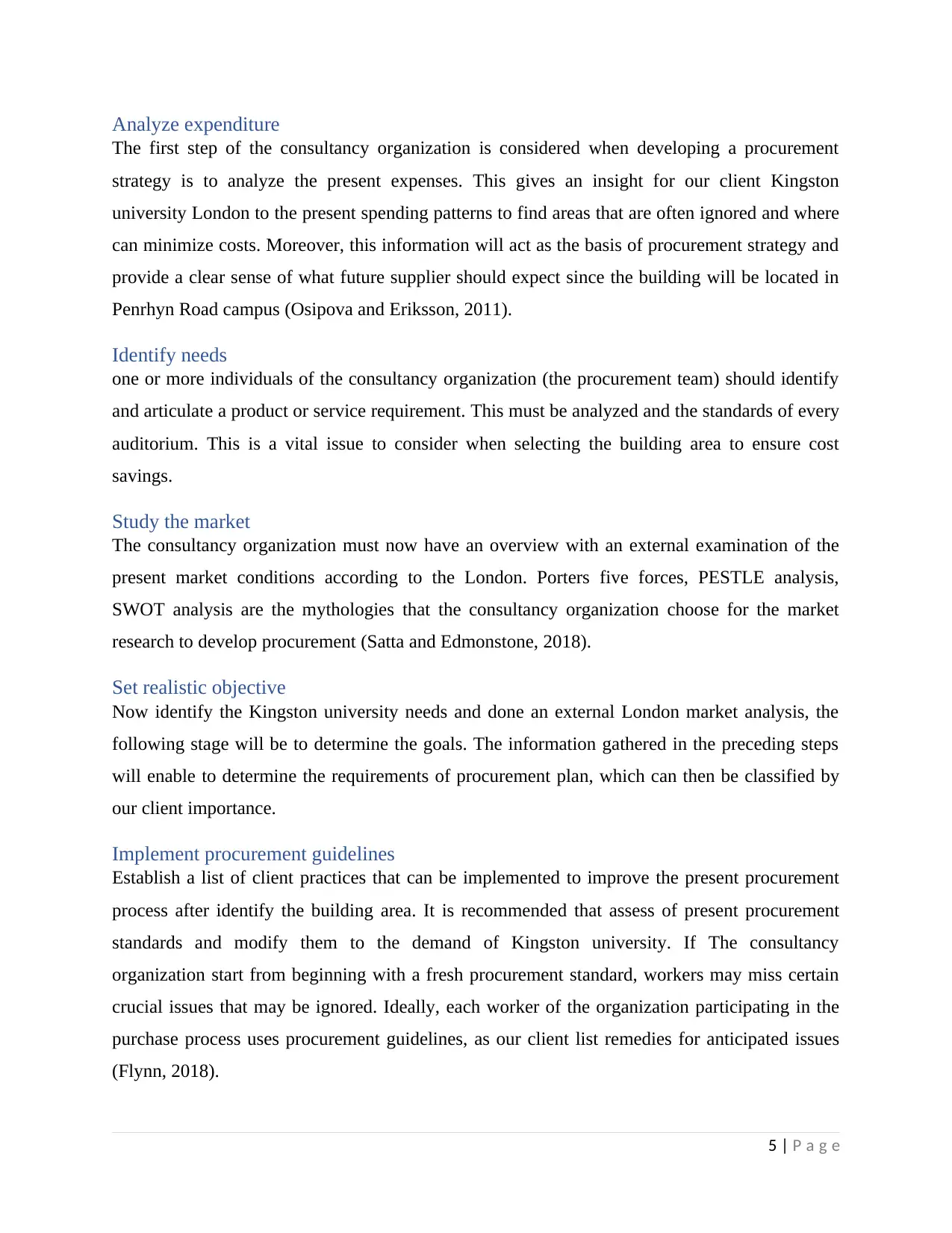
Analyze expenditure
The first step of the consultancy organization is considered when developing a procurement
strategy is to analyze the present expenses. This gives an insight for our client Kingston
university London to the present spending patterns to find areas that are often ignored and where
can minimize costs. Moreover, this information will act as the basis of procurement strategy and
provide a clear sense of what future supplier should expect since the building will be located in
Penrhyn Road campus (Osipova and Eriksson, 2011).
Identify needs
one or more individuals of the consultancy organization (the procurement team) should identify
and articulate a product or service requirement. This must be analyzed and the standards of every
auditorium. This is a vital issue to consider when selecting the building area to ensure cost
savings.
Study the market
The consultancy organization must now have an overview with an external examination of the
present market conditions according to the London. Porters five forces, PESTLE analysis,
SWOT analysis are the mythologies that the consultancy organization choose for the market
research to develop procurement (Satta and Edmonstone, 2018).
Set realistic objective
Now identify the Kingston university needs and done an external London market analysis, the
following stage will be to determine the goals. The information gathered in the preceding steps
will enable to determine the requirements of procurement plan, which can then be classified by
our client importance.
Implement procurement guidelines
Establish a list of client practices that can be implemented to improve the present procurement
process after identify the building area. It is recommended that assess of present procurement
standards and modify them to the demand of Kingston university. If The consultancy
organization start from beginning with a fresh procurement standard, workers may miss certain
crucial issues that may be ignored. Ideally, each worker of the organization participating in the
purchase process uses procurement guidelines, as our client list remedies for anticipated issues
(Flynn, 2018).
5 | P a g e
The first step of the consultancy organization is considered when developing a procurement
strategy is to analyze the present expenses. This gives an insight for our client Kingston
university London to the present spending patterns to find areas that are often ignored and where
can minimize costs. Moreover, this information will act as the basis of procurement strategy and
provide a clear sense of what future supplier should expect since the building will be located in
Penrhyn Road campus (Osipova and Eriksson, 2011).
Identify needs
one or more individuals of the consultancy organization (the procurement team) should identify
and articulate a product or service requirement. This must be analyzed and the standards of every
auditorium. This is a vital issue to consider when selecting the building area to ensure cost
savings.
Study the market
The consultancy organization must now have an overview with an external examination of the
present market conditions according to the London. Porters five forces, PESTLE analysis,
SWOT analysis are the mythologies that the consultancy organization choose for the market
research to develop procurement (Satta and Edmonstone, 2018).
Set realistic objective
Now identify the Kingston university needs and done an external London market analysis, the
following stage will be to determine the goals. The information gathered in the preceding steps
will enable to determine the requirements of procurement plan, which can then be classified by
our client importance.
Implement procurement guidelines
Establish a list of client practices that can be implemented to improve the present procurement
process after identify the building area. It is recommended that assess of present procurement
standards and modify them to the demand of Kingston university. If The consultancy
organization start from beginning with a fresh procurement standard, workers may miss certain
crucial issues that may be ignored. Ideally, each worker of the organization participating in the
purchase process uses procurement guidelines, as our client list remedies for anticipated issues
(Flynn, 2018).
5 | P a g e
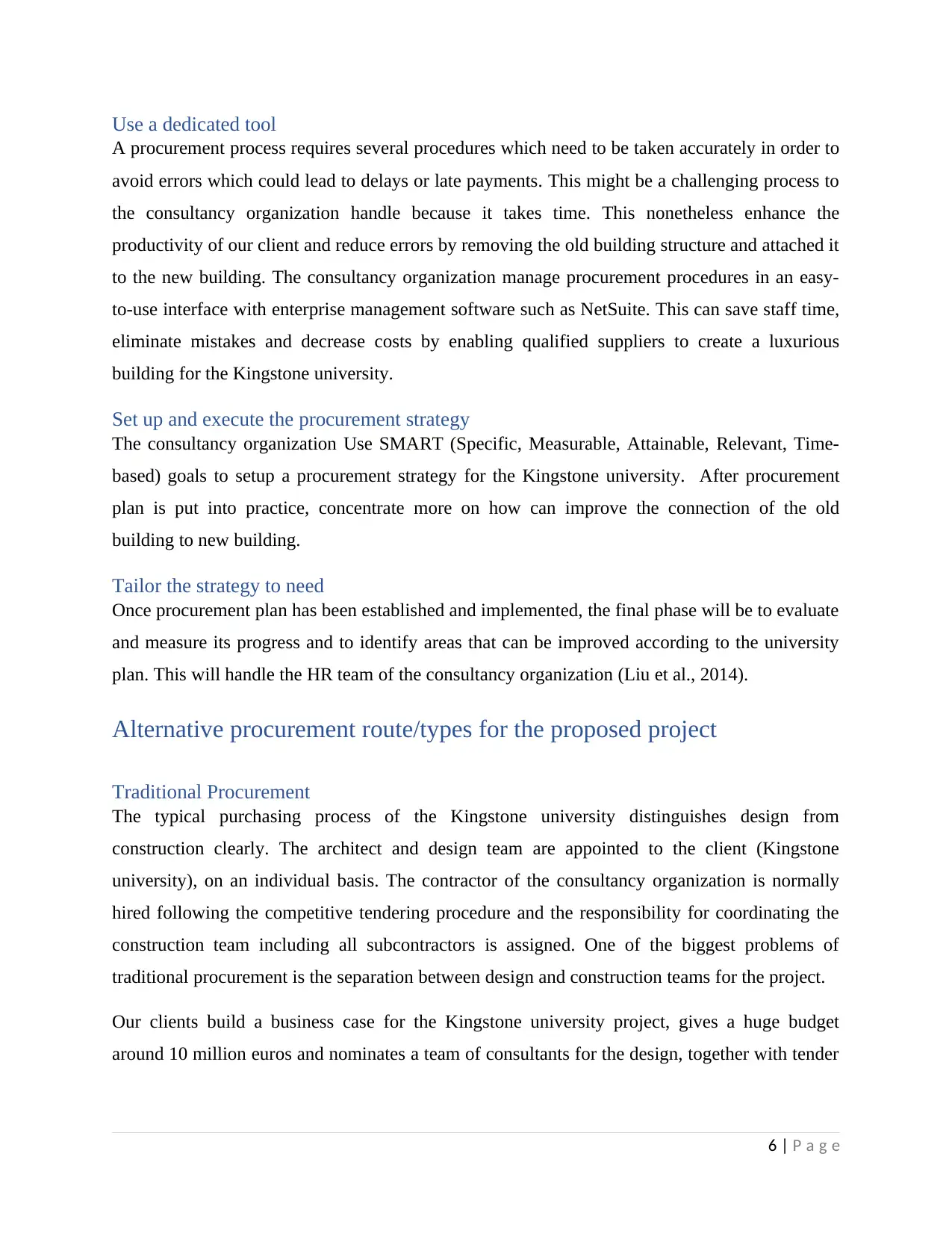
Use a dedicated tool
A procurement process requires several procedures which need to be taken accurately in order to
avoid errors which could lead to delays or late payments. This might be a challenging process to
the consultancy organization handle because it takes time. This nonetheless enhance the
productivity of our client and reduce errors by removing the old building structure and attached it
to the new building. The consultancy organization manage procurement procedures in an easy-
to-use interface with enterprise management software such as NetSuite. This can save staff time,
eliminate mistakes and decrease costs by enabling qualified suppliers to create a luxurious
building for the Kingstone university.
Set up and execute the procurement strategy
The consultancy organization Use SMART (Specific, Measurable, Attainable, Relevant, Time-
based) goals to setup a procurement strategy for the Kingstone university. After procurement
plan is put into practice, concentrate more on how can improve the connection of the old
building to new building.
Tailor the strategy to need
Once procurement plan has been established and implemented, the final phase will be to evaluate
and measure its progress and to identify areas that can be improved according to the university
plan. This will handle the HR team of the consultancy organization (Liu et al., 2014).
Alternative procurement route/types for the proposed project
Traditional Procurement
The typical purchasing process of the Kingstone university distinguishes design from
construction clearly. The architect and design team are appointed to the client (Kingstone
university), on an individual basis. The contractor of the consultancy organization is normally
hired following the competitive tendering procedure and the responsibility for coordinating the
construction team including all subcontractors is assigned. One of the biggest problems of
traditional procurement is the separation between design and construction teams for the project.
Our clients build a business case for the Kingstone university project, gives a huge budget
around 10 million euros and nominates a team of consultants for the design, together with tender
6 | P a g e
A procurement process requires several procedures which need to be taken accurately in order to
avoid errors which could lead to delays or late payments. This might be a challenging process to
the consultancy organization handle because it takes time. This nonetheless enhance the
productivity of our client and reduce errors by removing the old building structure and attached it
to the new building. The consultancy organization manage procurement procedures in an easy-
to-use interface with enterprise management software such as NetSuite. This can save staff time,
eliminate mistakes and decrease costs by enabling qualified suppliers to create a luxurious
building for the Kingstone university.
Set up and execute the procurement strategy
The consultancy organization Use SMART (Specific, Measurable, Attainable, Relevant, Time-
based) goals to setup a procurement strategy for the Kingstone university. After procurement
plan is put into practice, concentrate more on how can improve the connection of the old
building to new building.
Tailor the strategy to need
Once procurement plan has been established and implemented, the final phase will be to evaluate
and measure its progress and to identify areas that can be improved according to the university
plan. This will handle the HR team of the consultancy organization (Liu et al., 2014).
Alternative procurement route/types for the proposed project
Traditional Procurement
The typical purchasing process of the Kingstone university distinguishes design from
construction clearly. The architect and design team are appointed to the client (Kingstone
university), on an individual basis. The contractor of the consultancy organization is normally
hired following the competitive tendering procedure and the responsibility for coordinating the
construction team including all subcontractors is assigned. One of the biggest problems of
traditional procurement is the separation between design and construction teams for the project.
Our clients build a business case for the Kingstone university project, gives a huge budget
around 10 million euros and nominates a team of consultants for the design, together with tender
6 | P a g e
⊘ This is a preview!⊘
Do you want full access?
Subscribe today to unlock all pages.

Trusted by 1+ million students worldwide
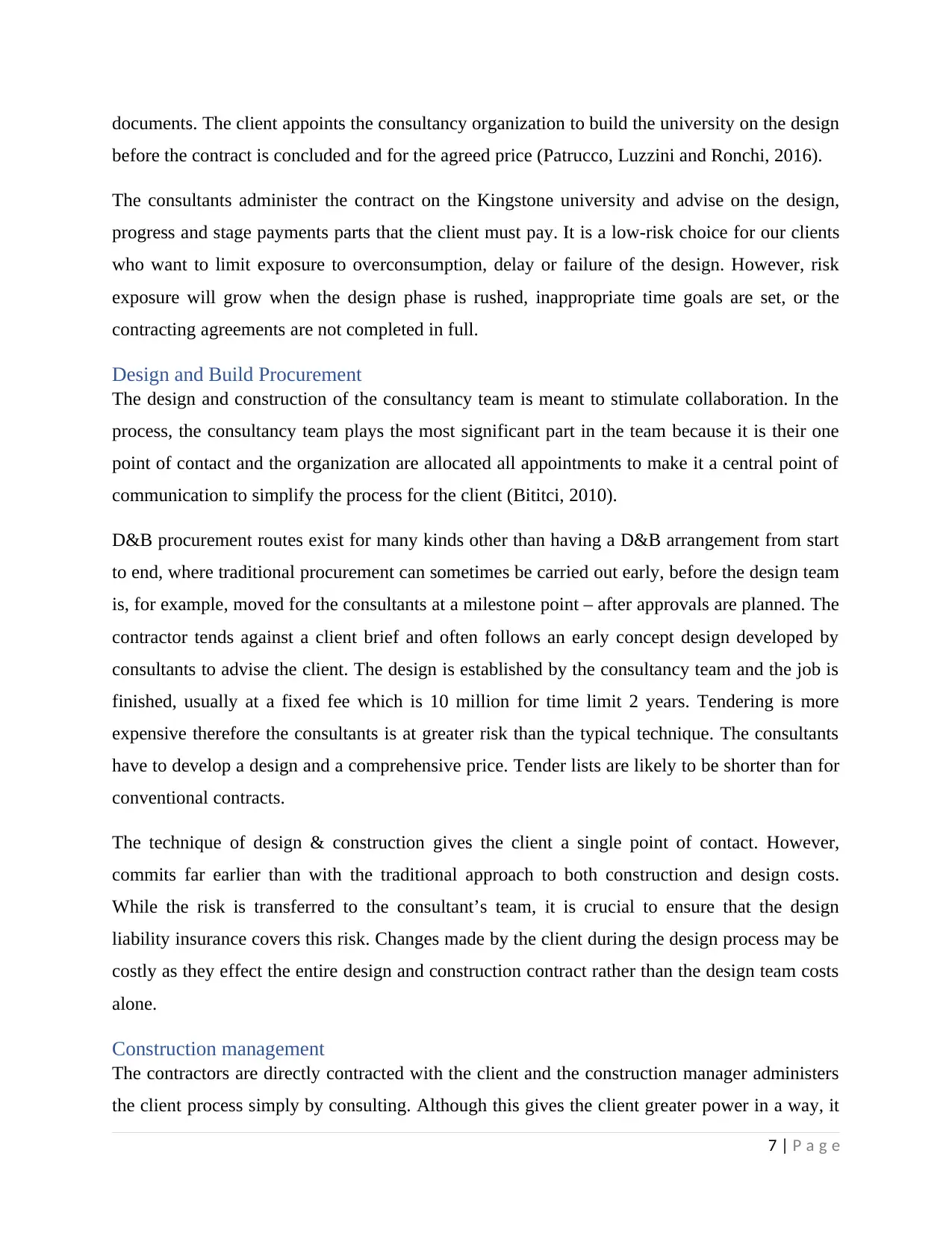
documents. The client appoints the consultancy organization to build the university on the design
before the contract is concluded and for the agreed price (Patrucco, Luzzini and Ronchi, 2016).
The consultants administer the contract on the Kingstone university and advise on the design,
progress and stage payments parts that the client must pay. It is a low-risk choice for our clients
who want to limit exposure to overconsumption, delay or failure of the design. However, risk
exposure will grow when the design phase is rushed, inappropriate time goals are set, or the
contracting agreements are not completed in full.
Design and Build Procurement
The design and construction of the consultancy team is meant to stimulate collaboration. In the
process, the consultancy team plays the most significant part in the team because it is their one
point of contact and the organization are allocated all appointments to make it a central point of
communication to simplify the process for the client (Bititci, 2010).
D&B procurement routes exist for many kinds other than having a D&B arrangement from start
to end, where traditional procurement can sometimes be carried out early, before the design team
is, for example, moved for the consultants at a milestone point – after approvals are planned. The
contractor tends against a client brief and often follows an early concept design developed by
consultants to advise the client. The design is established by the consultancy team and the job is
finished, usually at a fixed fee which is 10 million for time limit 2 years. Tendering is more
expensive therefore the consultants is at greater risk than the typical technique. The consultants
have to develop a design and a comprehensive price. Tender lists are likely to be shorter than for
conventional contracts.
The technique of design & construction gives the client a single point of contact. However,
commits far earlier than with the traditional approach to both construction and design costs.
While the risk is transferred to the consultant’s team, it is crucial to ensure that the design
liability insurance covers this risk. Changes made by the client during the design process may be
costly as they effect the entire design and construction contract rather than the design team costs
alone.
Construction management
The contractors are directly contracted with the client and the construction manager administers
the client process simply by consulting. Although this gives the client greater power in a way, it
7 | P a g e
before the contract is concluded and for the agreed price (Patrucco, Luzzini and Ronchi, 2016).
The consultants administer the contract on the Kingstone university and advise on the design,
progress and stage payments parts that the client must pay. It is a low-risk choice for our clients
who want to limit exposure to overconsumption, delay or failure of the design. However, risk
exposure will grow when the design phase is rushed, inappropriate time goals are set, or the
contracting agreements are not completed in full.
Design and Build Procurement
The design and construction of the consultancy team is meant to stimulate collaboration. In the
process, the consultancy team plays the most significant part in the team because it is their one
point of contact and the organization are allocated all appointments to make it a central point of
communication to simplify the process for the client (Bititci, 2010).
D&B procurement routes exist for many kinds other than having a D&B arrangement from start
to end, where traditional procurement can sometimes be carried out early, before the design team
is, for example, moved for the consultants at a milestone point – after approvals are planned. The
contractor tends against a client brief and often follows an early concept design developed by
consultants to advise the client. The design is established by the consultancy team and the job is
finished, usually at a fixed fee which is 10 million for time limit 2 years. Tendering is more
expensive therefore the consultants is at greater risk than the typical technique. The consultants
have to develop a design and a comprehensive price. Tender lists are likely to be shorter than for
conventional contracts.
The technique of design & construction gives the client a single point of contact. However,
commits far earlier than with the traditional approach to both construction and design costs.
While the risk is transferred to the consultant’s team, it is crucial to ensure that the design
liability insurance covers this risk. Changes made by the client during the design process may be
costly as they effect the entire design and construction contract rather than the design team costs
alone.
Construction management
The contractors are directly contracted with the client and the construction manager administers
the client process simply by consulting. Although this gives the client greater power in a way, it
7 | P a g e
Paraphrase This Document
Need a fresh take? Get an instant paraphrase of this document with our AI Paraphraser
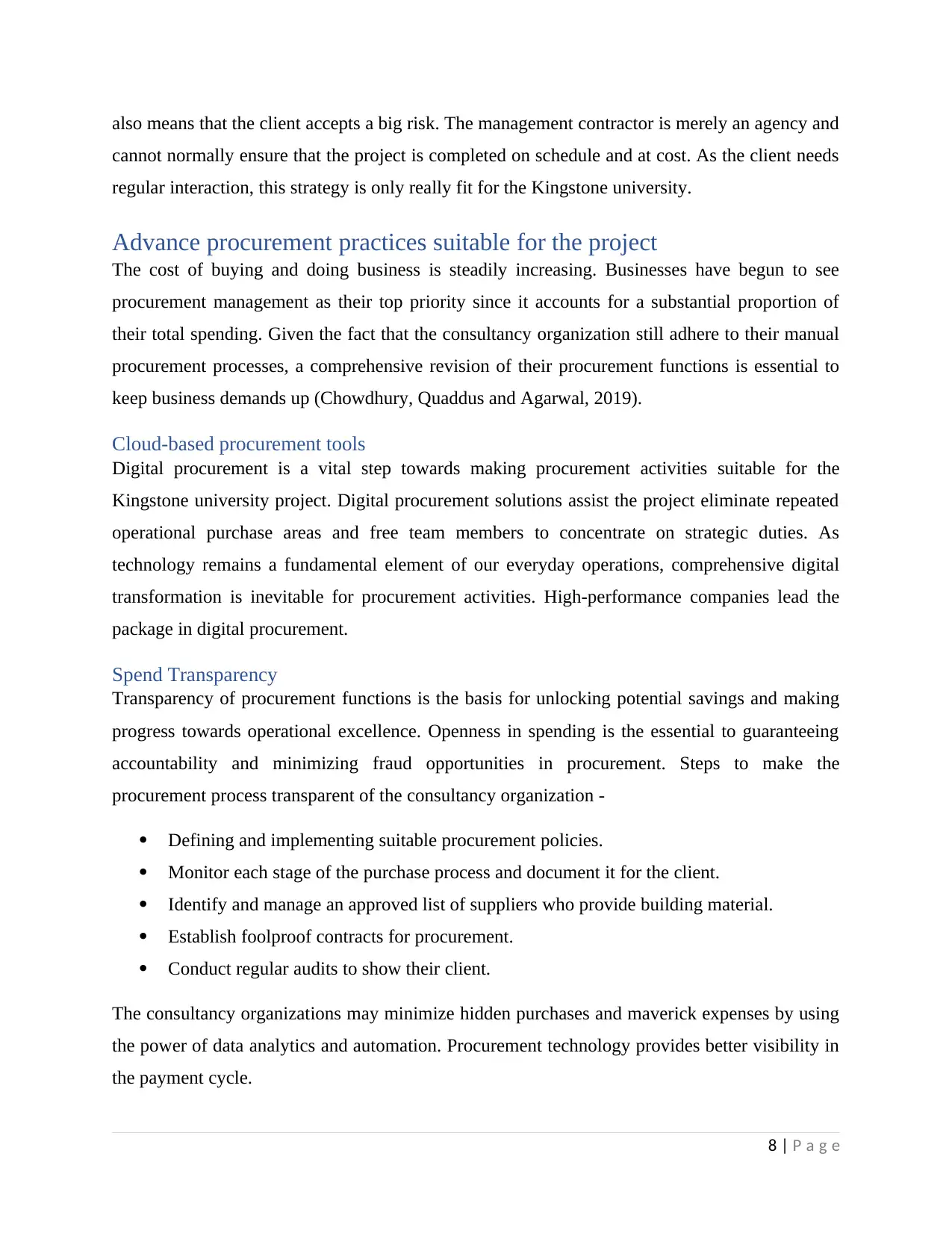
also means that the client accepts a big risk. The management contractor is merely an agency and
cannot normally ensure that the project is completed on schedule and at cost. As the client needs
regular interaction, this strategy is only really fit for the Kingstone university.
Advance procurement practices suitable for the project
The cost of buying and doing business is steadily increasing. Businesses have begun to see
procurement management as their top priority since it accounts for a substantial proportion of
their total spending. Given the fact that the consultancy organization still adhere to their manual
procurement processes, a comprehensive revision of their procurement functions is essential to
keep business demands up (Chowdhury, Quaddus and Agarwal, 2019).
Cloud-based procurement tools
Digital procurement is a vital step towards making procurement activities suitable for the
Kingstone university project. Digital procurement solutions assist the project eliminate repeated
operational purchase areas and free team members to concentrate on strategic duties. As
technology remains a fundamental element of our everyday operations, comprehensive digital
transformation is inevitable for procurement activities. High-performance companies lead the
package in digital procurement.
Spend Transparency
Transparency of procurement functions is the basis for unlocking potential savings and making
progress towards operational excellence. Openness in spending is the essential to guaranteeing
accountability and minimizing fraud opportunities in procurement. Steps to make the
procurement process transparent of the consultancy organization -
Defining and implementing suitable procurement policies.
Monitor each stage of the purchase process and document it for the client.
Identify and manage an approved list of suppliers who provide building material.
Establish foolproof contracts for procurement.
Conduct regular audits to show their client.
The consultancy organizations may minimize hidden purchases and maverick expenses by using
the power of data analytics and automation. Procurement technology provides better visibility in
the payment cycle.
8 | P a g e
cannot normally ensure that the project is completed on schedule and at cost. As the client needs
regular interaction, this strategy is only really fit for the Kingstone university.
Advance procurement practices suitable for the project
The cost of buying and doing business is steadily increasing. Businesses have begun to see
procurement management as their top priority since it accounts for a substantial proportion of
their total spending. Given the fact that the consultancy organization still adhere to their manual
procurement processes, a comprehensive revision of their procurement functions is essential to
keep business demands up (Chowdhury, Quaddus and Agarwal, 2019).
Cloud-based procurement tools
Digital procurement is a vital step towards making procurement activities suitable for the
Kingstone university project. Digital procurement solutions assist the project eliminate repeated
operational purchase areas and free team members to concentrate on strategic duties. As
technology remains a fundamental element of our everyday operations, comprehensive digital
transformation is inevitable for procurement activities. High-performance companies lead the
package in digital procurement.
Spend Transparency
Transparency of procurement functions is the basis for unlocking potential savings and making
progress towards operational excellence. Openness in spending is the essential to guaranteeing
accountability and minimizing fraud opportunities in procurement. Steps to make the
procurement process transparent of the consultancy organization -
Defining and implementing suitable procurement policies.
Monitor each stage of the purchase process and document it for the client.
Identify and manage an approved list of suppliers who provide building material.
Establish foolproof contracts for procurement.
Conduct regular audits to show their client.
The consultancy organizations may minimize hidden purchases and maverick expenses by using
the power of data analytics and automation. Procurement technology provides better visibility in
the payment cycle.
8 | P a g e
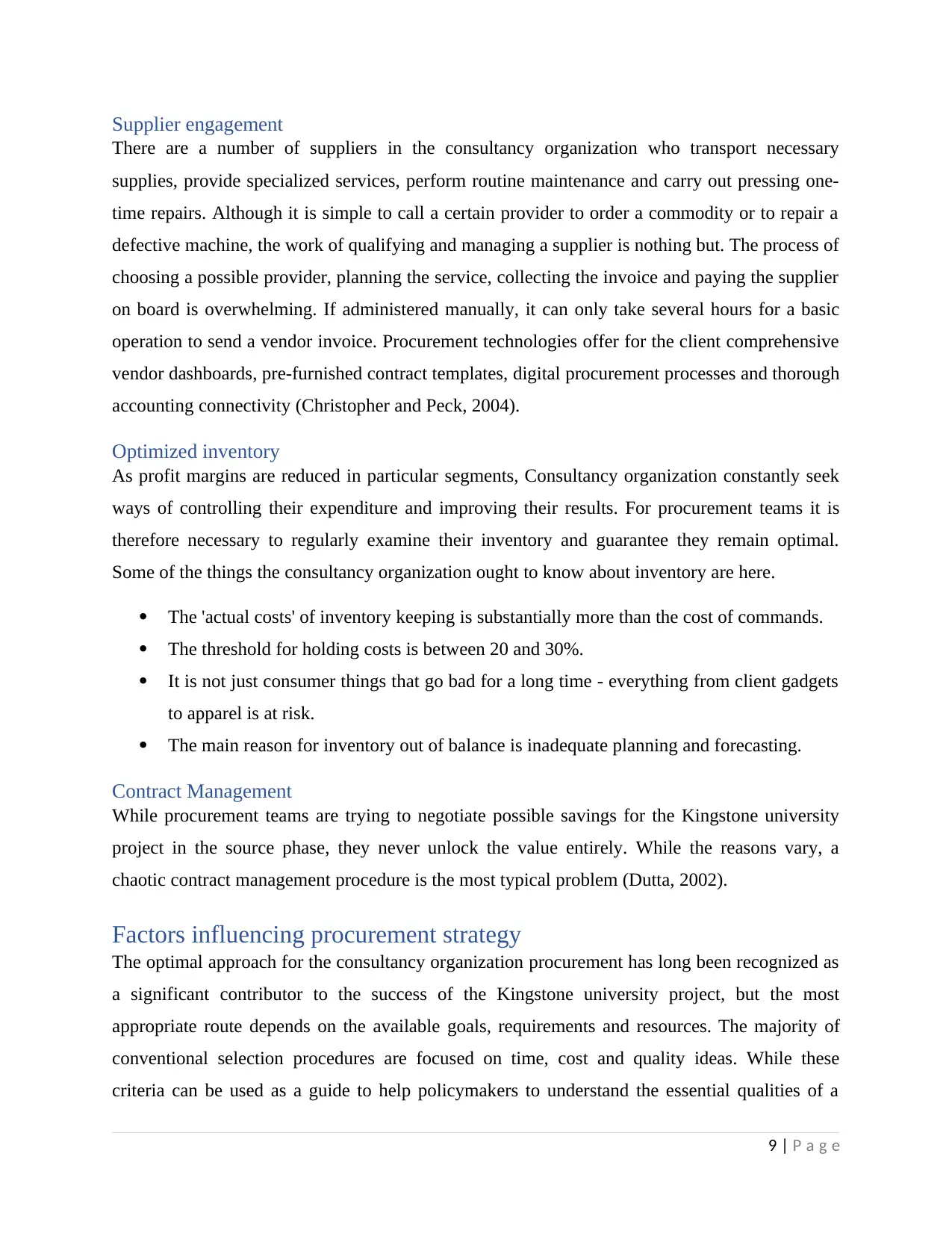
Supplier engagement
There are a number of suppliers in the consultancy organization who transport necessary
supplies, provide specialized services, perform routine maintenance and carry out pressing one-
time repairs. Although it is simple to call a certain provider to order a commodity or to repair a
defective machine, the work of qualifying and managing a supplier is nothing but. The process of
choosing a possible provider, planning the service, collecting the invoice and paying the supplier
on board is overwhelming. If administered manually, it can only take several hours for a basic
operation to send a vendor invoice. Procurement technologies offer for the client comprehensive
vendor dashboards, pre-furnished contract templates, digital procurement processes and thorough
accounting connectivity (Christopher and Peck, 2004).
Optimized inventory
As profit margins are reduced in particular segments, Consultancy organization constantly seek
ways of controlling their expenditure and improving their results. For procurement teams it is
therefore necessary to regularly examine their inventory and guarantee they remain optimal.
Some of the things the consultancy organization ought to know about inventory are here.
The 'actual costs' of inventory keeping is substantially more than the cost of commands.
The threshold for holding costs is between 20 and 30%.
It is not just consumer things that go bad for a long time - everything from client gadgets
to apparel is at risk.
The main reason for inventory out of balance is inadequate planning and forecasting.
Contract Management
While procurement teams are trying to negotiate possible savings for the Kingstone university
project in the source phase, they never unlock the value entirely. While the reasons vary, a
chaotic contract management procedure is the most typical problem (Dutta, 2002).
Factors influencing procurement strategy
The optimal approach for the consultancy organization procurement has long been recognized as
a significant contributor to the success of the Kingstone university project, but the most
appropriate route depends on the available goals, requirements and resources. The majority of
conventional selection procedures are focused on time, cost and quality ideas. While these
criteria can be used as a guide to help policymakers to understand the essential qualities of a
9 | P a g e
There are a number of suppliers in the consultancy organization who transport necessary
supplies, provide specialized services, perform routine maintenance and carry out pressing one-
time repairs. Although it is simple to call a certain provider to order a commodity or to repair a
defective machine, the work of qualifying and managing a supplier is nothing but. The process of
choosing a possible provider, planning the service, collecting the invoice and paying the supplier
on board is overwhelming. If administered manually, it can only take several hours for a basic
operation to send a vendor invoice. Procurement technologies offer for the client comprehensive
vendor dashboards, pre-furnished contract templates, digital procurement processes and thorough
accounting connectivity (Christopher and Peck, 2004).
Optimized inventory
As profit margins are reduced in particular segments, Consultancy organization constantly seek
ways of controlling their expenditure and improving their results. For procurement teams it is
therefore necessary to regularly examine their inventory and guarantee they remain optimal.
Some of the things the consultancy organization ought to know about inventory are here.
The 'actual costs' of inventory keeping is substantially more than the cost of commands.
The threshold for holding costs is between 20 and 30%.
It is not just consumer things that go bad for a long time - everything from client gadgets
to apparel is at risk.
The main reason for inventory out of balance is inadequate planning and forecasting.
Contract Management
While procurement teams are trying to negotiate possible savings for the Kingstone university
project in the source phase, they never unlock the value entirely. While the reasons vary, a
chaotic contract management procedure is the most typical problem (Dutta, 2002).
Factors influencing procurement strategy
The optimal approach for the consultancy organization procurement has long been recognized as
a significant contributor to the success of the Kingstone university project, but the most
appropriate route depends on the available goals, requirements and resources. The majority of
conventional selection procedures are focused on time, cost and quality ideas. While these
criteria can be used as a guide to help policymakers to understand the essential qualities of a
9 | P a g e
⊘ This is a preview!⊘
Do you want full access?
Subscribe today to unlock all pages.

Trusted by 1+ million students worldwide
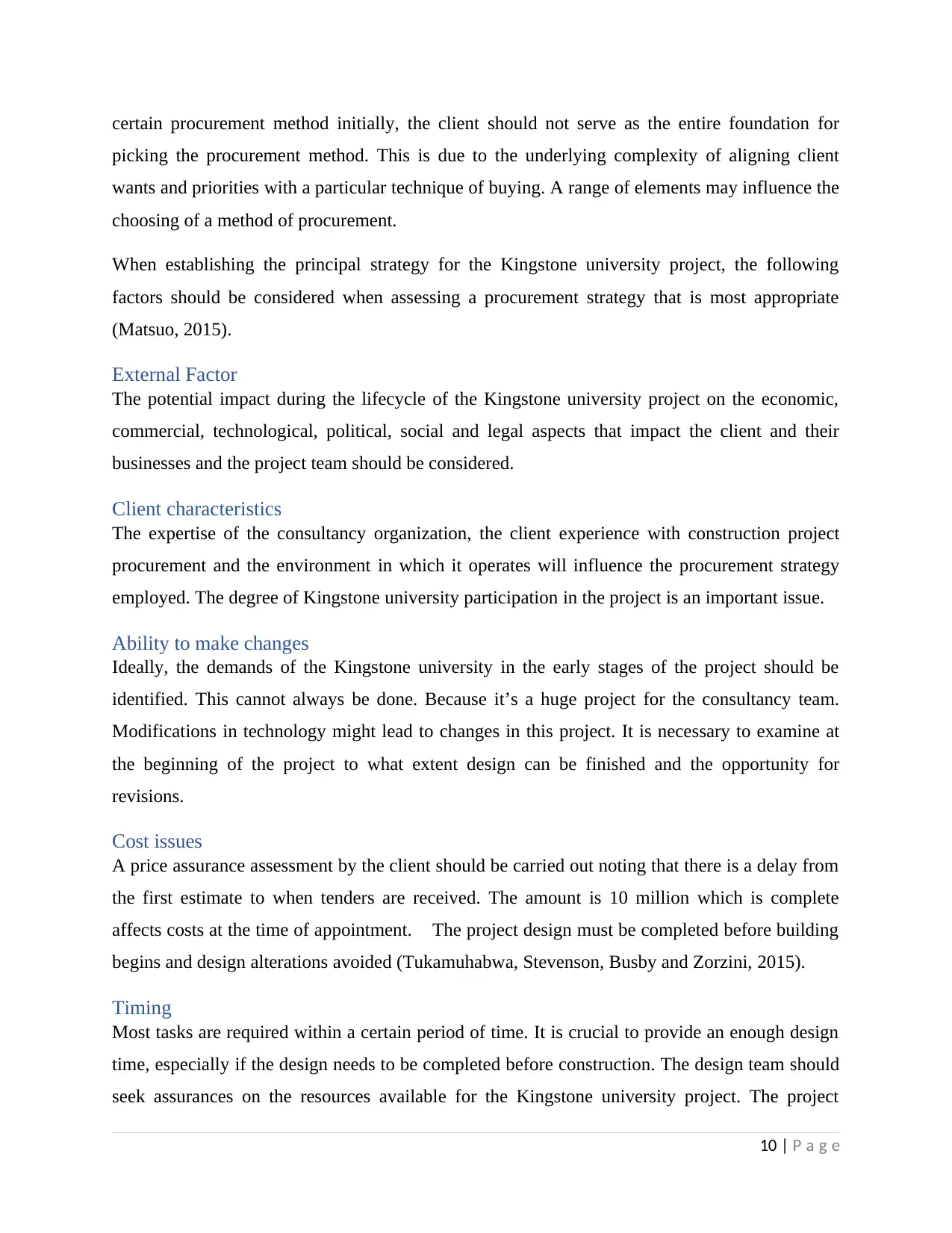
certain procurement method initially, the client should not serve as the entire foundation for
picking the procurement method. This is due to the underlying complexity of aligning client
wants and priorities with a particular technique of buying. A range of elements may influence the
choosing of a method of procurement.
When establishing the principal strategy for the Kingstone university project, the following
factors should be considered when assessing a procurement strategy that is most appropriate
(Matsuo, 2015).
External Factor
The potential impact during the lifecycle of the Kingstone university project on the economic,
commercial, technological, political, social and legal aspects that impact the client and their
businesses and the project team should be considered.
Client characteristics
The expertise of the consultancy organization, the client experience with construction project
procurement and the environment in which it operates will influence the procurement strategy
employed. The degree of Kingstone university participation in the project is an important issue.
Ability to make changes
Ideally, the demands of the Kingstone university in the early stages of the project should be
identified. This cannot always be done. Because it’s a huge project for the consultancy team.
Modifications in technology might lead to changes in this project. It is necessary to examine at
the beginning of the project to what extent design can be finished and the opportunity for
revisions.
Cost issues
A price assurance assessment by the client should be carried out noting that there is a delay from
the first estimate to when tenders are received. The amount is 10 million which is complete
affects costs at the time of appointment. The project design must be completed before building
begins and design alterations avoided (Tukamuhabwa, Stevenson, Busby and Zorzini, 2015).
Timing
Most tasks are required within a certain period of time. It is crucial to provide an enough design
time, especially if the design needs to be completed before construction. The design team should
seek assurances on the resources available for the Kingstone university project. The project
10 | P a g e
picking the procurement method. This is due to the underlying complexity of aligning client
wants and priorities with a particular technique of buying. A range of elements may influence the
choosing of a method of procurement.
When establishing the principal strategy for the Kingstone university project, the following
factors should be considered when assessing a procurement strategy that is most appropriate
(Matsuo, 2015).
External Factor
The potential impact during the lifecycle of the Kingstone university project on the economic,
commercial, technological, political, social and legal aspects that impact the client and their
businesses and the project team should be considered.
Client characteristics
The expertise of the consultancy organization, the client experience with construction project
procurement and the environment in which it operates will influence the procurement strategy
employed. The degree of Kingstone university participation in the project is an important issue.
Ability to make changes
Ideally, the demands of the Kingstone university in the early stages of the project should be
identified. This cannot always be done. Because it’s a huge project for the consultancy team.
Modifications in technology might lead to changes in this project. It is necessary to examine at
the beginning of the project to what extent design can be finished and the opportunity for
revisions.
Cost issues
A price assurance assessment by the client should be carried out noting that there is a delay from
the first estimate to when tenders are received. The amount is 10 million which is complete
affects costs at the time of appointment. The project design must be completed before building
begins and design alterations avoided (Tukamuhabwa, Stevenson, Busby and Zorzini, 2015).
Timing
Most tasks are required within a certain period of time. It is crucial to provide an enough design
time, especially if the design needs to be completed before construction. The design team should
seek assurances on the resources available for the Kingstone university project. The project
10 | P a g e
Paraphrase This Document
Need a fresh take? Get an instant paraphrase of this document with our AI Paraphraser
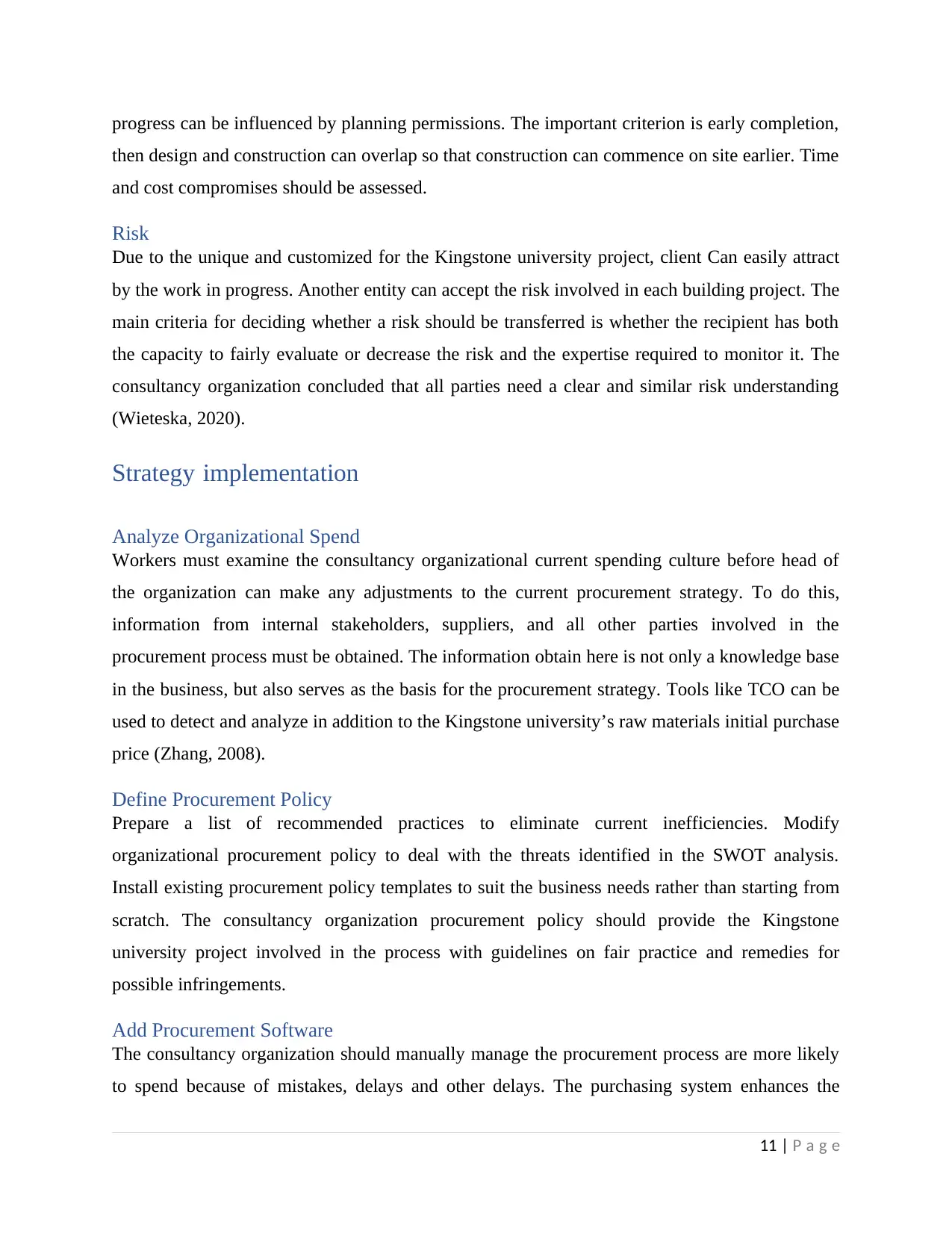
progress can be influenced by planning permissions. The important criterion is early completion,
then design and construction can overlap so that construction can commence on site earlier. Time
and cost compromises should be assessed.
Risk
Due to the unique and customized for the Kingstone university project, client Can easily attract
by the work in progress. Another entity can accept the risk involved in each building project. The
main criteria for deciding whether a risk should be transferred is whether the recipient has both
the capacity to fairly evaluate or decrease the risk and the expertise required to monitor it. The
consultancy organization concluded that all parties need a clear and similar risk understanding
(Wieteska, 2020).
Strategy implementation
Analyze Organizational Spend
Workers must examine the consultancy organizational current spending culture before head of
the organization can make any adjustments to the current procurement strategy. To do this,
information from internal stakeholders, suppliers, and all other parties involved in the
procurement process must be obtained. The information obtain here is not only a knowledge base
in the business, but also serves as the basis for the procurement strategy. Tools like TCO can be
used to detect and analyze in addition to the Kingstone university’s raw materials initial purchase
price (Zhang, 2008).
Define Procurement Policy
Prepare a list of recommended practices to eliminate current inefficiencies. Modify
organizational procurement policy to deal with the threats identified in the SWOT analysis.
Install existing procurement policy templates to suit the business needs rather than starting from
scratch. The consultancy organization procurement policy should provide the Kingstone
university project involved in the process with guidelines on fair practice and remedies for
possible infringements.
Add Procurement Software
The consultancy organization should manually manage the procurement process are more likely
to spend because of mistakes, delays and other delays. The purchasing system enhances the
11 | P a g e
then design and construction can overlap so that construction can commence on site earlier. Time
and cost compromises should be assessed.
Risk
Due to the unique and customized for the Kingstone university project, client Can easily attract
by the work in progress. Another entity can accept the risk involved in each building project. The
main criteria for deciding whether a risk should be transferred is whether the recipient has both
the capacity to fairly evaluate or decrease the risk and the expertise required to monitor it. The
consultancy organization concluded that all parties need a clear and similar risk understanding
(Wieteska, 2020).
Strategy implementation
Analyze Organizational Spend
Workers must examine the consultancy organizational current spending culture before head of
the organization can make any adjustments to the current procurement strategy. To do this,
information from internal stakeholders, suppliers, and all other parties involved in the
procurement process must be obtained. The information obtain here is not only a knowledge base
in the business, but also serves as the basis for the procurement strategy. Tools like TCO can be
used to detect and analyze in addition to the Kingstone university’s raw materials initial purchase
price (Zhang, 2008).
Define Procurement Policy
Prepare a list of recommended practices to eliminate current inefficiencies. Modify
organizational procurement policy to deal with the threats identified in the SWOT analysis.
Install existing procurement policy templates to suit the business needs rather than starting from
scratch. The consultancy organization procurement policy should provide the Kingstone
university project involved in the process with guidelines on fair practice and remedies for
possible infringements.
Add Procurement Software
The consultancy organization should manually manage the procurement process are more likely
to spend because of mistakes, delays and other delays. The purchasing system enhances the
11 | P a g e
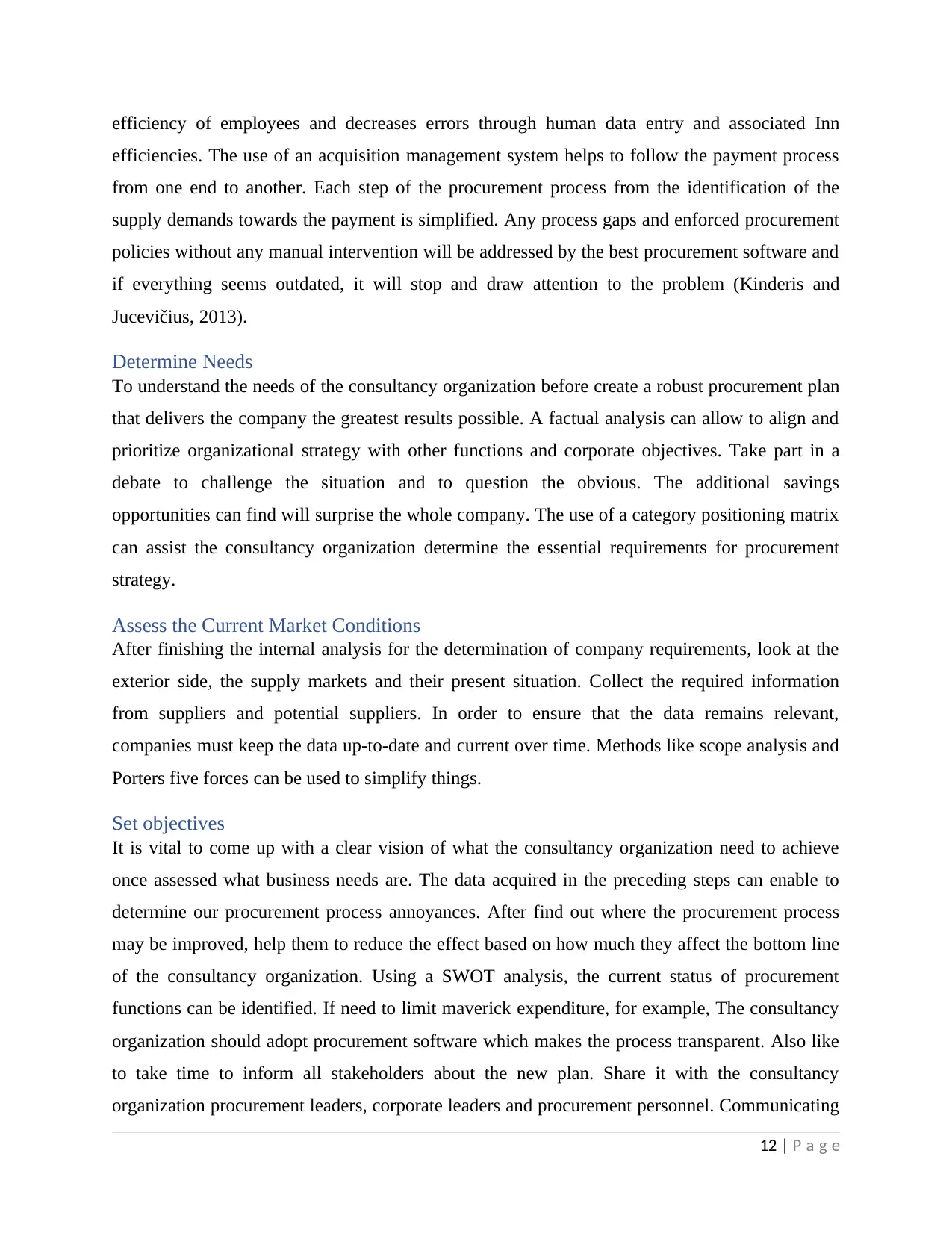
efficiency of employees and decreases errors through human data entry and associated Inn
efficiencies. The use of an acquisition management system helps to follow the payment process
from one end to another. Each step of the procurement process from the identification of the
supply demands towards the payment is simplified. Any process gaps and enforced procurement
policies without any manual intervention will be addressed by the best procurement software and
if everything seems outdated, it will stop and draw attention to the problem (Kinderis and
Jucevičius, 2013).
Determine Needs
To understand the needs of the consultancy organization before create a robust procurement plan
that delivers the company the greatest results possible. A factual analysis can allow to align and
prioritize organizational strategy with other functions and corporate objectives. Take part in a
debate to challenge the situation and to question the obvious. The additional savings
opportunities can find will surprise the whole company. The use of a category positioning matrix
can assist the consultancy organization determine the essential requirements for procurement
strategy.
Assess the Current Market Conditions
After finishing the internal analysis for the determination of company requirements, look at the
exterior side, the supply markets and their present situation. Collect the required information
from suppliers and potential suppliers. In order to ensure that the data remains relevant,
companies must keep the data up-to-date and current over time. Methods like scope analysis and
Porters five forces can be used to simplify things.
Set objectives
It is vital to come up with a clear vision of what the consultancy organization need to achieve
once assessed what business needs are. The data acquired in the preceding steps can enable to
determine our procurement process annoyances. After find out where the procurement process
may be improved, help them to reduce the effect based on how much they affect the bottom line
of the consultancy organization. Using a SWOT analysis, the current status of procurement
functions can be identified. If need to limit maverick expenditure, for example, The consultancy
organization should adopt procurement software which makes the process transparent. Also like
to take time to inform all stakeholders about the new plan. Share it with the consultancy
organization procurement leaders, corporate leaders and procurement personnel. Communicating
12 | P a g e
efficiencies. The use of an acquisition management system helps to follow the payment process
from one end to another. Each step of the procurement process from the identification of the
supply demands towards the payment is simplified. Any process gaps and enforced procurement
policies without any manual intervention will be addressed by the best procurement software and
if everything seems outdated, it will stop and draw attention to the problem (Kinderis and
Jucevičius, 2013).
Determine Needs
To understand the needs of the consultancy organization before create a robust procurement plan
that delivers the company the greatest results possible. A factual analysis can allow to align and
prioritize organizational strategy with other functions and corporate objectives. Take part in a
debate to challenge the situation and to question the obvious. The additional savings
opportunities can find will surprise the whole company. The use of a category positioning matrix
can assist the consultancy organization determine the essential requirements for procurement
strategy.
Assess the Current Market Conditions
After finishing the internal analysis for the determination of company requirements, look at the
exterior side, the supply markets and their present situation. Collect the required information
from suppliers and potential suppliers. In order to ensure that the data remains relevant,
companies must keep the data up-to-date and current over time. Methods like scope analysis and
Porters five forces can be used to simplify things.
Set objectives
It is vital to come up with a clear vision of what the consultancy organization need to achieve
once assessed what business needs are. The data acquired in the preceding steps can enable to
determine our procurement process annoyances. After find out where the procurement process
may be improved, help them to reduce the effect based on how much they affect the bottom line
of the consultancy organization. Using a SWOT analysis, the current status of procurement
functions can be identified. If need to limit maverick expenditure, for example, The consultancy
organization should adopt procurement software which makes the process transparent. Also like
to take time to inform all stakeholders about the new plan. Share it with the consultancy
organization procurement leaders, corporate leaders and procurement personnel. Communicating
12 | P a g e
⊘ This is a preview!⊘
Do you want full access?
Subscribe today to unlock all pages.

Trusted by 1+ million students worldwide
1 out of 17
Related Documents
Your All-in-One AI-Powered Toolkit for Academic Success.
+13062052269
info@desklib.com
Available 24*7 on WhatsApp / Email
![[object Object]](/_next/static/media/star-bottom.7253800d.svg)
Unlock your academic potential
Copyright © 2020–2025 A2Z Services. All Rights Reserved. Developed and managed by ZUCOL.





